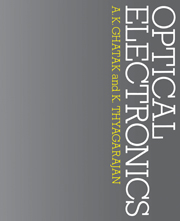Book contents
- Frontmatter
- Contents
- Preface
- 1 Maxwell's equations and propagation of electromagnetic waves
- 2 Reflection and refraction of electromagnetic waves
- 3 Wave propagation in anisotropic media
- 4 Fraunhofer diffraction
- 5 Fresnel diffraction
- 6 Spatial frequency filtering
- 7 Holography
- 8 Lasers: I
- 9 Lasers: II
- 10 Some laser systems
- 11 Electromagnetic analysis of the simplest optical waveguide
- 12 Leaky modes in optical waveguides
- 13 Optical fibre waveguides
- 14 Integrated optics
- 15 The electrooptic effect
- 16 The strain optic tensor
- 17 Acoustooptlc effect: Raman–Nath diffraction
- 18 Acoustooptic effect: Bragg diffraction
- 19 Acoustooptic devices
- 20 Nonlinear optics
- Appendices
- References and suggested reading
- Index
10 - Some laser systems
Published online by Cambridge University Press: 05 June 2012
- Frontmatter
- Contents
- Preface
- 1 Maxwell's equations and propagation of electromagnetic waves
- 2 Reflection and refraction of electromagnetic waves
- 3 Wave propagation in anisotropic media
- 4 Fraunhofer diffraction
- 5 Fresnel diffraction
- 6 Spatial frequency filtering
- 7 Holography
- 8 Lasers: I
- 9 Lasers: II
- 10 Some laser systems
- 11 Electromagnetic analysis of the simplest optical waveguide
- 12 Leaky modes in optical waveguides
- 13 Optical fibre waveguides
- 14 Integrated optics
- 15 The electrooptic effect
- 16 The strain optic tensor
- 17 Acoustooptlc effect: Raman–Nath diffraction
- 18 Acoustooptic effect: Bragg diffraction
- 19 Acoustooptic devices
- 20 Nonlinear optics
- Appendices
- References and suggested reading
- Index
Summary
Introduction
In this chapter we shall discuss some specilc laser systems and their important operating characteristics. The systems that we shall consider are some of the more important lasers that are in widespread use today for different applications. The lasers considered are:
(a) solid state lasers: ruby, Nd:YAG, Nd: glass;
(b) gas lasers: He–Ne, argon ion and CO2;
(c) liquid lasers: dyes;
(d) excimer lasers;
(e) semiconductor lasers.
Ruby lasers
The irst laser to be operated successfully was the ruby laser which was fabricated by Maiman in 1960, Ruby, which is the lasing medium, consists of a matrix of aluminium oxide in which some of the aluminium, ions are replaced by chromium ions. It is the energy levels of the chromium ions which take part in the lasing action. Typical concentrations of chromium ions are ∼0,05% by weight. The energy level diagram of the chromium ion is shown in Fig. 10.1. As is evident from the figure this is a three level laser. The pumping of the chromium ions is performed with the help of flash lamp (e.g., a xenon or krypton flashlamp) and the chromium ions in the ground state absorb radiation around wavelengths of 5500 Å and 4000 Å and are excited to the levels marked E1 and E2. The chromium ions excited to these levels relax rapidly through a nonradiative transition (in a time ∼ 10-8–10-9s) to the level marked M which is the upper laser level.
- Type
- Chapter
- Information
- Optical Electronics , pp. 294 - 314Publisher: Cambridge University PressPrint publication year: 1989



